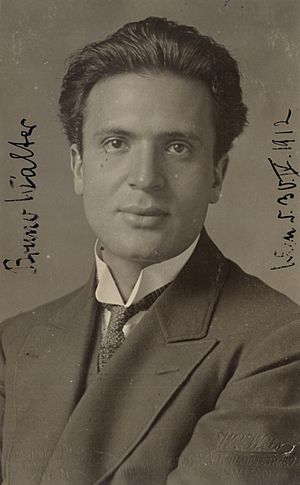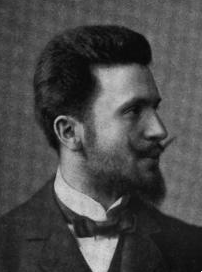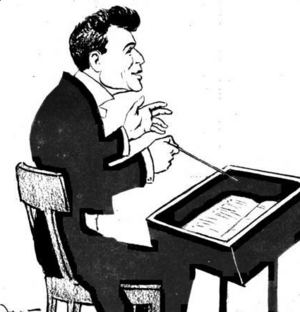Bruno Walter facts for kids
Quick facts for kids
Bruno Walter
|
|
|---|---|

Bruno Walter, Vienna, 1912
|
|
| Born |
Bruno Schlesinger
September 15, 1876 |
| Died | February 17, 1962 (aged 85) Beverly Hills, California, U.S.
|
| Occupation | Composer, conductor, pianist |
| Years active | 1889–1962 |
Bruno Walter (born Bruno Schlesinger, September 15, 1876 – February 17, 1962) was a famous German-born conductor, pianist, and composer. He was born in Berlin. In 1933, he had to leave Nazi Germany. He became a French citizen in 1938 and moved to the United States in 1939.
Walter worked closely with Gustav Mahler, a very important composer. He helped make Mahler's music well-known. Walter held important jobs with many famous orchestras and opera houses. These included the New York Philharmonic and the Vienna State Opera. He made many important recordings and is known as one of the greatest conductors of the 20th century.
Contents
Biography
Early Life and Musical Start
Bruno Walter was born near Alexanderplatz in Berlin. His family was Jewish and middle-class. He started learning music at the Stern Conservatory when he was eight years old. When he was nine, he played the piano in public for the first time. He even played a full piano concerto with the Berlin Philharmonic in 1890.
He also studied how to compose music. But in 1889, he heard the Berlin Philharmonic led by Hans von Bülow. This concert changed his life. He wrote that he then knew he was "meant for" conducting an orchestra. He had his first conducting job at the Cologne Opera in 1894. Later that year, he moved to the Hamburg State Opera to work with the chorus. There, he met and worked with Gustav Mahler. Walter greatly admired Mahler and later became very connected to his music.
Becoming a Conductor
In 1896, Walter became the main conductor at the Stadttheater in Wrocław. Gustav Mahler had recommended him for the job. However, the theater's director asked Walter to change his last name from Schlesinger. This was because the name was very common in that area. Walter found changing his name "terrible," but he did it. He chose the name Bruno Walter.
Walter moved to different cities for conducting jobs. In 1897, he was Chief Conductor in Pressburg (now Bratislava). In 1898, he became Chief Conductor of the Latvian National Opera in Riga. While there, he became a Christian. In 1899, he was appointed music director of the Temeswar Opera (now Timișoara, Romania).
In 1900, Walter returned to Berlin. He became a Royal Prussian Conductor at the Berlin State Opera. He worked alongside famous musicians like Richard Strauss.
Working with Mahler in Vienna
In 1901, Mahler invited Walter to be his assistant at the Court Opera in Vienna. Walter conducted Verdi's Aida for his first performance there. In 1907, the Vienna Philharmonic chose him to conduct one of their concerts.
Walter's reputation as a conductor grew quickly. He was invited to conduct all over Europe, including in Prague, London, and Rome. When Mahler passed away in 1911, Walter was with him. Walter then conducted the first performances of two of Mahler's most important works: Das Lied von der Erde in 1911 and Symphony No. 9 in 1912.
Time in Munich
In 1913, Walter moved to Munich to become the Royal Bavarian Music Director. He also became the General Music Director of the Bavarian State Opera. During his time in Munich, Walter played a big part in performing Wagner's operas. The Bayreuth Festival, which usually performed Wagner, was closed for a while. So, Munich became the main place to hear authentic Wagner performances. Walter led many of these.
During World War I, he continued to conduct. He led the first performances of several new operas by composers like Erich Wolfgang Korngold and Hans Pfitzner. In Munich, Walter became good friends with Thomas Mann, a famous writer.
Moving to the United States
Walter left Munich in 1922. In 1923, he traveled to New York and worked with the New York Symphony Orchestra at Carnegie Hall. He also conducted in other American cities like Detroit and Boston.
Back in Europe and Facing Challenges
Returning to Europe, Walter conducted with the Leipzig Gewandhaus Orchestra and the Royal Concertgebouw Orchestra in 1923. He was also the Music Director of the Deutsche Oper Berlin from 1925 to 1929. He conducted at La Scala in Italy and at Covent Garden in London.
From 1929, Walter was the main conductor of the Leipzig Gewandhaus Orchestra. However, his time there was cut short in March 1933 when the new Nazi government came to power.
The Nazis began to remove Jewish people from artistic life. When Adolf Hitler became Chancellor in 1933, Walter was in New York. He returned to Leipzig for scheduled concerts. But the police stopped his concerts, saying there might be "unpleasant demonstrations." Walter chose to withdraw and left Germany. He would not conduct there again until after the war.
Austria became his main place to work for several years. He and his family moved to Vienna. There, he regularly conducted the Vienna Philharmonic and at the Salzburg Festival. In 1936, he became the Artistic Director of the Vienna State Opera. He also worked as a guest conductor for the Royal Concertgebouw Orchestra in Amsterdam.
In 1938, Nazi Germany took over Austria. Walter was in the Netherlands at the time. His older daughter, Lotte, was arrested by the Nazis in Vienna. Walter used his influence to help her get free. He also helped his brother and sister find safe places in Scandinavia during the war.
Sadly, Walter's daughter Gretel was killed in 1939 by her husband. Walter's wife became very depressed and passed away in 1945. Walter felt responsible for the tragedy.
Permanent Home in the United States
On November 1, 1939, Bruno Walter moved to the United States permanently. He settled in Beverly Hills, California. Many other artists and writers who had left Europe also lived there, including Thomas Mann.
Walter was deeply influenced by the philosopher Rudolf Steiner and his ideas called anthroposophy. Walter wrote that Steiner's teachings brought new understanding to his life and even improved his music.
In the United States, Walter worked with many famous American orchestras. In 1942, he was offered the job of music director for the New York Philharmonic. He turned it down because of his age. But in 1947, he accepted a role as "Music Adviser" for them. He also conducted the Chicago Symphony Orchestra, the Los Angeles Philharmonic, and the Philadelphia Orchestra.
From 1946 onwards, he often returned to Europe. He was an important figure at the Edinburgh International Festival and in Salzburg, Vienna, and Munich. In 1950, he went back to Berlin for the first time since 1933. He conducted the Berlin Philharmonic and gave a lecture at his old music school.
In his later years, he made many stereo recordings with the Columbia Symphony Orchestra. This was a group of musicians put together by Columbia Records just for recordings. His last live concert was on December 4, 1960, with the Los Angeles Philharmonic. His very last recording was of Mozart overtures in March 1961.
Death
Bruno Walter passed away from a heart attack at his home in Beverly Hills in 1962. He is buried in Switzerland.
Work
Recordings
Bruno Walter made hundreds of recordings between 1900 and 1961. Many people know his work from the stereo recordings he made in his final years. Some experts say these later recordings sound more gentle. His earlier recordings were often more energetic and intense. Also, his later recordings focused on older music, but when he was younger, he often conducted newer pieces.
Walter worked very closely with Gustav Mahler. Mahler passed away before he could perform his own works, Das Lied von der Erde and Symphony No. 9. Mahler's wife asked Walter to conduct the first performances of both. Walter led the first performance of Das Lied in 1911 and the Ninth Symphony in 1912.
Decades later, Walter and the Vienna Philharmonic made the first recordings of Das Lied von der Erde in 1936 and the Ninth Symphony in 1938. These were recorded live during concerts. The recording of the Ninth Symphony was made just two months before the Nazis took over Austria, forcing Walter to leave.
These early recordings are very special because they show how the orchestra played back then. Walter later re-recorded both works successfully. His famous 1952 recording of Das Lied von der Erde with Kathleen Ferrier is very well-known. He recorded it again in stereo in 1960. He also recorded Mahler's Second and Ninth Symphonies in stereo in the late 1950s and early 1960s.
Since Mahler himself never conducted the Ninth Symphony or Das Lied von der Erde, Walter's performances are not exactly what Mahler would have done. However, because Walter worked so closely with Mahler and gave the first performances, his recordings are still very important. For his other recordings of Mahler's music, Walter had heard Mahler perform them himself, which adds to their value.
Walter also made many highly praised recordings of other great composers. These include Mozart, Haydn, Beethoven, Schubert, and Johannes Brahms. He was also a leading opera conductor. Recordings of Mozart's Don Giovanni and The Marriage of Figaro, and Beethoven's Fidelio are available. There are also interesting recordings from the 1950s of his rehearsals. These show his musical ideas and his kind way of working with orchestras.
Compositions
Bruno Walter composed music until about 1910. Some of his compositions include:
- Symphony No. 1 in D minor (premiered in Vienna, 1909)
- Symphony No. 2 in E
- Symphonic Fantasia (premiered by Richard Strauss in 1904)
- String Quartet in D major (1903)
- Piano Quintet (premiered in 1905)
- Sonata for Violin and Piano in A (circa 1908)
- Music for the play "King Oedipus" (1910)
- Many songs
- Choral Works
Written Works
Walter also wrote several books and articles about music and his life. Some of his notable written works include:
- Gustav Mahler (1936) – a book about the composer
- Theme and Variations – Memories and Thoughts (1947) – his autobiography
- Of Music and Making Music (1957)
- My Path to Anthroposophy (1961)
Notable Recordings
- 1935: Richard Wagner, Die Walküre (Act I), with the Vienna Philharmonic Orchestra.
- 1938: Gustav Mahler, Symphony No. 9, with the Vienna Philharmonic Orchestra.
- 1941: Ludwig van Beethoven, Fidelio, with the Metropolitan Opera.
- 1952: Gustav Mahler, Das Lied von der Erde, with the Vienna Philharmonic Orchestra, featuring soloists Kathleen Ferrier and Julius Patzak.
- 1956: The Birth of a Performance: Walter's rehearsals and final performance of Mozart's "Linz" Symphony, with the Columbia Symphony Orchestra. This was one of the first times rehearsals were released commercially.
- 1958–1961: Ludwig van Beethoven, Symphony No. 4, Symphony No. 6 and Symphony No. 9, with the Columbia Symphony Orchestra.
- 1960: Johannes Brahms, Symphony No. 2 and Symphony No. 3, with the Columbia Symphony Orchestra.
See also
 In Spanish: Bruno Walter para niños
In Spanish: Bruno Walter para niños




